配对题。请从选项中选择与之相对应的研究方法。 What do students to improve their English out of the class time?A.Survey researchB.Experimental researchC.Correlational researchD.Causal-comparative research
题目
配对题。请从选项中选择与之相对应的研究方法。 What do students to improve their English out of the class time?
A.Survey research
B.Experimental research
C.Correlational research
D.Causal-comparative research
相似考题
参考答案和解析
更多“配对题。请从选项中选择与之相对应的研究方法。 What do students to improve their English out of the class time?”相关问题
-
第1题:
What is the main idea of this passage?
A. It is important to be on time for class in the United States.
B. The importance of being on time differs among cultures.
C. People learn' the importance of time from the culture they are in.
D. Students being late for class should explain the reason to their teacher.
正确答案:B55.答案为B 从文章中教授的经历和调查可得知守时的重要性在不同文化中的差异,因此B为正确答案。
-
第2题:
What's the overall goal of English teaching in basic education stage?A.Increase students' vocabulary and grammar of the knowledge.
B.Improve students' English learning and foreign cultural interesting.
C.Cultivate students' ability of listening and spoken English.
D.Cultivate students' comprehensive capability of language.
答案:D解析:考查英语教学目标。基础教育阶段英语教学的总体目标是培养学生综合运用语言的能力。 -
第3题:

二、考题解析
【教案】
Teaching aims:
Knowledge aim:
Students will master the expression of date and the sentence structure: -What is ...’s birthday? -It is ...
Ability aim:
Students will improve their abilities of speaking and listening.
Emotional aim:
Students will be more confident in speaking English.
Key and difficult point:
Key Point: Students will master how to express a date in English.
Difficult Point: Students will use the sentence structure in daily life.
Teaching procedure:
Step 1: Warming-up
1. Greetings.
2. Ask students if today is anyone’s birthday. And invite the whole class to sing a ‘Happy Birthday’ song to him or her.
Step 2: Pre-listening
1. Review the knowledge about ordinal numeral: write some numbers on the blackboard and ask students to change the cardinal numeral into ordinal numeral.
2. Ask students to look at the picture in the textbook to predict what the dialogue may be about.
Step 3: While-listening
1st listening: Ask students to listen to the tape for the first time and check if their prediction is correct or not.
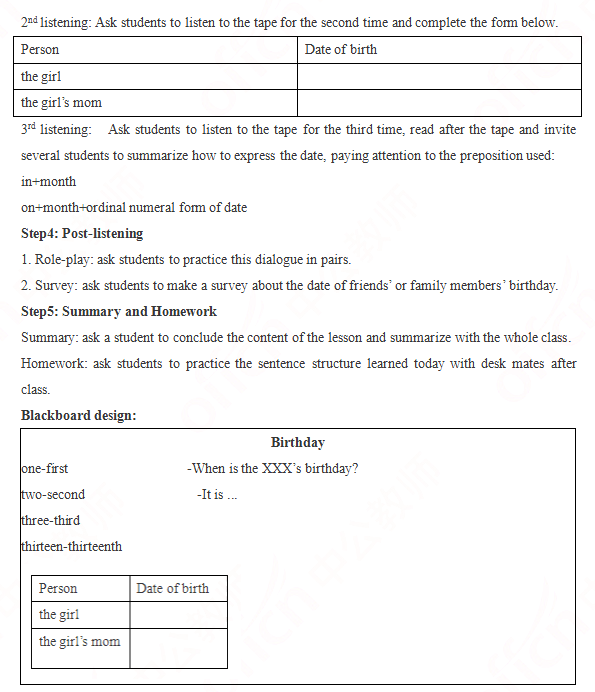
答案:解析:暂无解析 -
第4题:
小学英语?阅读
一、考题回顾
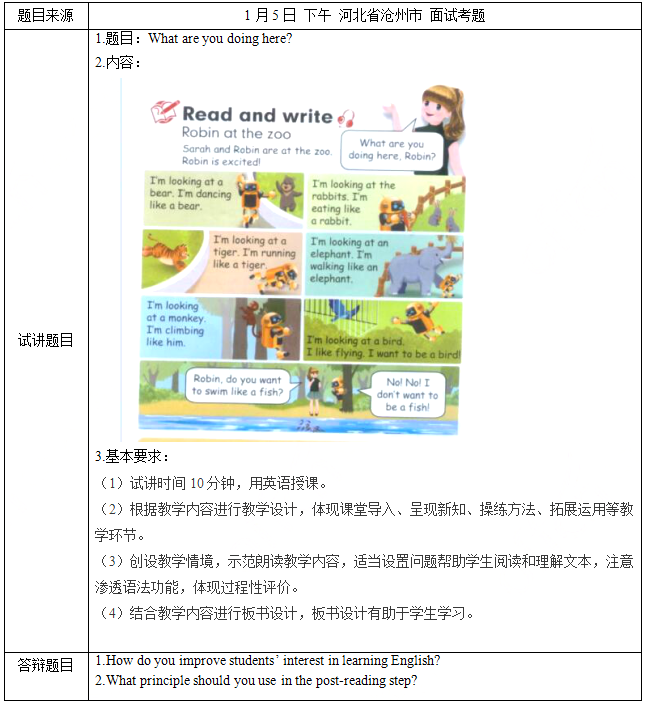
二、考题解析
【教学设计】
Teaching aims:
Knowledge aim:
Students will master the meaning and usage of the structure “be doing” through reading the passage.
Ability aim:
Students will apply the “be doing” to communicate with each other in real situation.
Emotional aim:
Students will be more interest in learning English.
Key and difficult point:
Key Point: Students will master how to improve reading abilities through finding main idea and details.
Difficult Point: Students will apply the “be doing” to communicate with each other in real situation.
Teaching procedure:
Step 1: Warming-up
1. Greetings.
2. Play a riddle and students guess the animals, such as “long nose, big ears and strong body——elephant”, then lead to the topic of “let’s go to the zoo to see what animals are doing”.
Step 2: Pre-reading
1. According to the title, students have a prediction about what kinds of animals are mentioned in the passage.
Step 3: While-reading
1. Fast reading: students read the passage fast and figure out what kinds of animals are mentioned in the passage then make a list.
2. Careful reading: students read the passage carefully and answer the question: what are the animals doing? Then fill in the blanks.
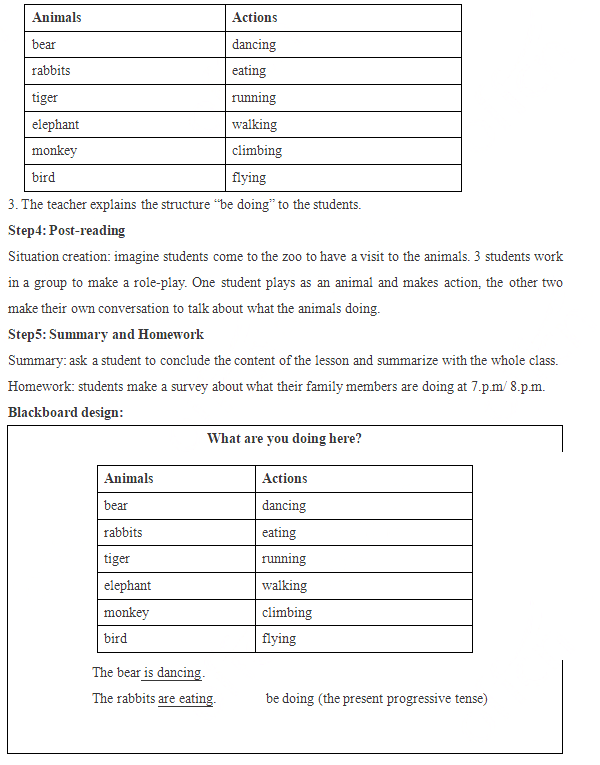
1. How do you improve students’ interest in learning English?
2. What principle should you use in the post-reading step?答案:解析:1.
In the process of English teaching, teachers should enrich the teaching approaches, not only teach students through "listening, speaking, reading", but also integrate situational teaching, so that students can feel the diversity of teaching and learning.
Besides, teachers can make use of the form of cooperative study and organize various practice activities in the classroom to create an atmosphere of mutual assistance and cooperation, so that students have positive sense of learning.
2.
First, we should persist in the communicative principle. In the production step of reading
class, students should be organized in groups to cultivate their speaking ability and communicative ability. In this way, we can reach the New Curriculum Standard.
Then, we should insist on the truth principle. That means we should provide more real materials that are closet to students’ real life, such as situation creation like what I did in this class. In this way, students’ interest can be aroused and they can apply what they’ve learned in real communication. -
第5题:
小学英语?听说
一、考题回顾
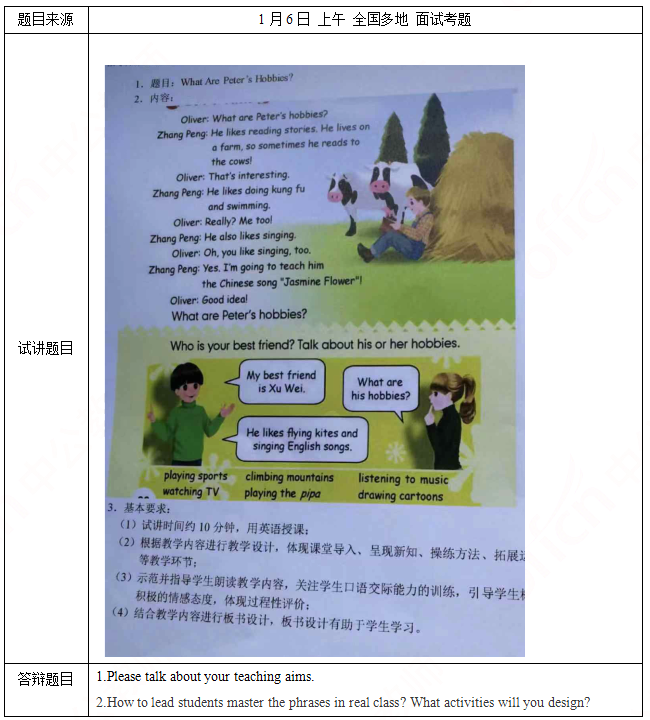
二、考题解析
【教案】
Teaching aims:
Knowledge aim:
Students will master some phrases about hobbies and the sentence structure about how to talk about hobbies
Ability aim:
Students will improve their speaking ability in talking about hobbies.
Emotional aim:
Students will be more confident in speaking English.
Students will arouse their interest in learning oral English.
Key and difficult point:
Key Point: How to talk about hobbies.
Difficult Point:
Students will be more confident in speaking English.
Students will arouse their interest in learning oral English.
Teaching procedure:
Step 1: Warming-up
1. Greeting.
2. Chant: Dog, dog, what can you do?
I can run after you.
Panda, panda, what can you do?
I can eat so much bamboo.
Mouse, mouse, what can you do?
I can hide in the shoe.
Mike, Mike, what can you do?
I can draw animals in the zoo!
Step 2: Presentation
1. Read the dialogue by the teacher, and ask what the dialogue is about. (It’s about Peter’s hobbies)
2. Let the students find what Peter’s hobbies are. And tell them we can use what’s ..’s hobbies? to ask others’ hobby.
He likes reading stories, doing Kung fu and swimming and he also like singing.
Meanwhile I will use pictures and actions to help them understand these phrases and add -s after like when we meet he/she/it and v-ing follows the verb like.
Step 3: Practice
1.Listen to the tape and try to follow it. Then give them 5 minutes to role play the conversation in pairs.
2.Invite volunteer to answer my question: who is your best friend? What are his/her hobbies.
Step 4: Production
Work in group of four to do a survey ask group members two questions: who is your best friend? What are his/her hobbies. Fill in the chart and then do a report in 7mins.
Step5: Summary and Homework
Summary: make a brief summary of what we have learned today.
Homework: Ask their parents what their hobbies are and draw their hobbies down.
Blackboard design:

1.Please talk about your teaching aims.
2.How to lead students master the phrases in real class? What activities will you design?答案:解析:1.
Knowledge aim:
Students will master some phrases about hobbies and the sentence structure about how to talk about hobbies
Ability aim:
Students will improve their speaking ability in talking about hobbies.
Emotional aim:
Students will be more confident in speaking English.
Students will arouse their interest in learning oral English.
2.
Due to the limited time I design few activities. In real class. I will give students more example to understand the function of the sentence structure. At the same time, more practice will be used such as the mechanical drilling: filling in the blanks with the correct form of verbs and make up sentences with given words. And meaningful drilling describe the pictures and so on. -
第6题:
初中英语?听说
一、考题回顾
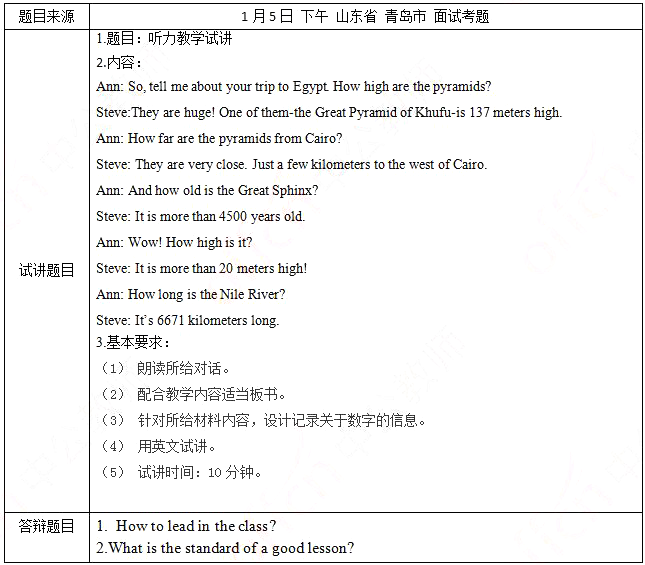
二、考题解析
【教案】
Teaching aims:
Knowledge aim:
Students will master the sentence structure: How far...? How high...? How long....? and so on.
Ability aim:
Students will improve their abilities of speaking and listening.
Emotional aim:
Students will be more confident in speaking English and use the sentence structures in daily life.
Key and difficult point:
Key Point: Students will master how to describe the height and distance in English.
Difficult Point: Students will use the sentence structures in daily life.
Teaching procedure:
Step 1: Warming-up
1. Greetings.
2. Sing a song called Five hundred away to lead in the class.
Step 2: Pre-listening
1. Show students some pictures of the Great Pyramid of Khufu and the Great Sphinx. Let them to predict what we will learn today.
Step 3: While-listening
1st listening: Ask students to listen to the tape for the first time and check if their prediction is correct or not and try to get the main idea of the dialogue.
2nd listening: Ask students to listen to the tape for the second time and answer the following questions.
①. How far are the pyramids from Cairo?
②. How old is the Great Sphinx?
③. How long is the Nile River?
3rd listening: Ask students to listen to the tape for the third time, read after the tape and invite several students to
Step4: Post-listening
Role-play: ask students to work in pairs. One works as an interviewer, and the other works as an interviewee to make a dialogue about an unforgettable trip. And give them five minutes to prepare it.
Step5: Summary and Homework
Summary: ask a student to conclude the content of the lesson and summarize with the whole class.
Homework: ask students to search the Internet to find more information about Africa.
Blackboard design:

1. How to lead in the class?
2. What is the standard of a good lesson?答案:解析:1.
Warming up is very important for a new lesson. Teachers can use many ways to lead in, such as riddle, story, picture, video, music and so on. Such as sing a song that is related to the topic of the new lesson for students to lead in the class. It can arouse the interest of students and make the atmosphere of class become active and lead in the new lesson easily.
2.
The standards of a good lesson are as follows: embody advanced teaching idea, a clear teaching goal, break through the key and difficult points successfully. It can give students' subjectivity to the full play, can use flexible teaching methods and so on. -
第7题:
高中英语?阅读
一、考题回顾

二、考题解析
【教案】
Teaching aims:
Knowledge aim:
Students can know the basic meaning of passage and are able to master the different greeting for the strangers.
Ability aims:
Students can practice guessing content of next paragraph according to the clues which is given in the passage.
Emotional aim:
Students are able to love learning English and like to read different English passage after this lesson.
Key and difficult point:
Key Point: guess the content of next paragraph according to the clues and know the “learned” body language, especially different greetings
Difficult Point: improve students’ reading interest.
Teaching procedures:
Step 1: Warming-up
1. Greetings.
2. Play a video about Chaplin’s mime and ask students several questions:
What kind of body language can you see from this video?
Do you know the meaning of these body language?
Step 2: Pre-reading
Present the passage on the screen and read it for all the students. Before reading, ask students one question: What’s the main ideas of these two paragraphs? And guess the main to topic of this lesson?
Then invite several students to share their ideas.
Step 3: While-reading
1.Lead the students to think one question: Is this a whole passage? And ask students to scan the whole passage and give the teacher answer.
2.Ask students to discuss in group and after 10 minutes to invite several students to share their ideas with all the students.
3.And different students may be just guess the content of several paragraphs. So give students a chart, ask them to finish discussing in 5 minutes. Then invite two representatives to state the whole passage.

Step4: Post-reading
Guessing game: Present another passage on the screen. And give students 10 minutes to read and discuss.Then make a chart and tell your own stories according to chart in your own group .Then invite the representatives to make a report for the whole class.
Step5: Summary and Homework
Summary: ask a student to conclude the content of the lesson and summarize with the whole class.
Homework: Present a passage and ask students to read and write a short passsage,which will be put behind of last paragraph.
Blackboard design:

1.Do you have the experience in teaching?
2. What will you do if you pass this exam?答案:解析:1.
Yes, I do. I have taught a teenager in high school. She was the junior. I mainly taught her grammar. I found her grammar was not very systematic. So I taught her from the grammar in words to the grammar in sentences in order to make her master the whole grammar, especially those always appeared in her exams. And during the teaching, I find the most important that it is the teacher should have a better understanding of the whole grammar and the high school English course. Besides, the teacher should pay more attention to the patience. It will make students relax when their learning and get along with the students.
2.
First, I will find a teaching job to practice my teaching ability. And at the same time to prepare the teachers’ exams for school. When I prepare, I think the most important it’s to know the content of text in high school and do many exercises to practice these knowledge.
Second, I will visit some good teachers who is teaching the high school and learn some experience and practice my teaching ability.
Last, I need to reflect myself to improve my knowledge and my teaching procedures. -
第8题:
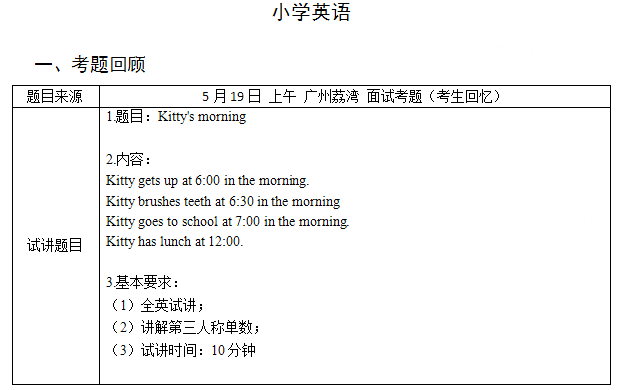
二、考题解析
【教案】
Teaching Aims:
Knowledge aim: Students will master the changes of third person singular verbs.
Ability aim: Students can use sentence to describe what other people do in their daily life.
Emotional aim: Students will improve their interest in English and realize they should cherish the time.
Teaching Key Points:
Students know how to describe daily activities at exact time.
Teaching Difficult Points:
Students can apply the structure into daily communication.
Teaching Methods:
Inductive teaching method, TPR teaching method, Communicative teaching method, task-based teaching method.
Teaching Aids:
Pictures, Blackboard and so on.
Teaching Procedures:
Step 1: Warming up
1.Greetings
2.Sing a chant, invite the whole students to do the action when singing together.
In the morning GO GO GO
Brush your teeth! Brush your teeth! In the morning SHUA SHUA SHUA
Go to school! Go to school! In the morning GO GO GO
Step 2: Presentation
1.Show Students four pictures to review the words get up, brush teeth, have lunch, go to school
2.Say sentences to the Students and let them find out what the changes are.
e.g. I get up at 6:00 in the morning. Kitty gets up at 6:00 in the morning.
e.g. I brush teeth at 6:30 in the morning. Kitty brushes teeth at 6:30 in the morning.
......
3.Make a conclusion. When we say he/she/other’s name, we change the words ‘get-gets’, ‘brush-brushes’, ‘have-has’, ‘go-goes’.
Step 3: Practice
Invite one student coming in front, do the action and let other students say the sentence: He/She goes to school.
Step 4: Production
Make a survey: Let students work in their group of four. They’ll be given 15 minutes to ask some questions with each other and fill in the survey table about what they do at what time. After that, invite some students to share their survey result by saying ‘XX gets up at 6:30’, etc.
Step 5: Summary & Homework
Summary: Invite a student to be a small teacher, to make a summary about what we have learned today.
Homework: Let students to think and design ‘A Day of Peppa Pig’. They may draw some pictures. Tomorrow two of them will be invited to share their works and say some sentences to introduce a day of Peppa Pig.
Blackboard design:
 答案:解析:暂无解析
答案:解析:暂无解析 -
第9题:
小学英语?阅读
一、考题回顾
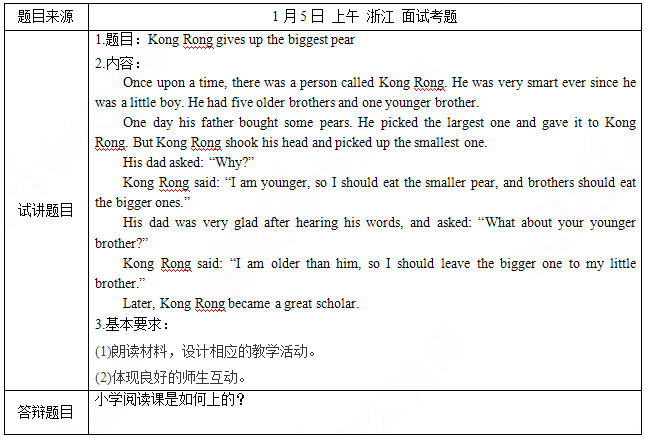
二、考题解析
【教案】
Teaching aims:
Knowledge aim:
Students will master the Chinese classical story of Kong Rong giving the big pear to brothers.
Ability aim:
Students will improve their reading skills including the skimming and scanning.
Emotional aim:
Students will be more interest in learning Chinese old story.
Key and difficult point:
Key Point: Students will master how to improve reading abilities through finding main idea and details.
Difficult Point: Students will share their feelings after reading the story.
Teaching procedure:
Step 1: Warming-up
1. Greetings.
2. Sing a song “If you’re happy”, then ask students why I’m happy and tell them in this class I will tell them an interesting story.
Step 2: Pre-reading
1. Show a picture of pear, and students have a brainstorm of what stories they can think of related to the pear.
Step 3: While-reading
Global reading: students read the passage fast and what stories it is about. Then find the main character and time of the story.
Detailed reading: students read the passage carefully and answer the question:
1. What did Kong Rong do when his father gives him one of the biggest pears?
2. Why did he do that in such way?
Step4: Post-reading
1. Role-play: 3 students in a group to play as Kong Rong, the father and the narrator, and they make a role-play in 10 minutes.
2. Discussion: students work in pairs to discuss what kind of person Kong Rong is and what they can learn from Kong Rong.
Step5: Summary and Homework
Summary: Ask a student to conclude the content of the lesson and summarize with the whole class.
Homework: Ask students to search another Chinese old story and make a poster.
Blackboard design:

1. How do you teach students in reading class?答案:解析:1.
Reading ability plays an increasingly important role in primary school, so when I teach reading class, I will cultivate students’ reading strategies that includes skimming and scanning. Namely, first students read the passage fast to get the main idea or simple clue of the passage. After that, they can read it carefully to get the details in order to have a whole understanding of the passage. Finally, they may have a discussion to share their opinions about the passage, so that their mind would be opened or their critical thinking could be developed. -
第10题:
一、标题不可缺少
What are you doing?
二、教学目标撰写要以学生为主语
Teaching aims:
(1) Knowledge aims
Students can master the key sentence structure “what are you doing?” .
(2) Ability aims
Students can communicate with their partners by using the new sentence.
(3)Emotional aims
Students will be more interested in sharing their ideas with others and take part the group activity.
Teaching key point
Master the new sentence structure.
Teaching difficult point
Describe what other people are doing.
Teaching Methods:
Situational teaching method, task-based teaching method
Teaching Aids:
PPT
三、教学过程要完成清晰
Teaching procedure
Step 1 Warming-up
At the beginning of class, ask students a question about what do they usually do on weekend. Students may have different answer like go to the zoo, stay at home and so on. Then teacher ask: “do you want to know what others are doing now?” to lead to the topic today, and write it down on the blackboard.
(step can give students chances to speak English ,and get a good preparation for the next step—the presentation part, student’s interest will be aroused as they can share the things they know with others in English. It can also help nurture students’ confidence.)
Step 2 Pre-reading
Show the picture about the Larry’s home, letting students guessing what happened and predict the content about the reading material.
(Justification: guessing part will focus students’ attention on the main topic of the reading passage. It prepares students to think critically about the topic and provides them with the opportunity to connect some aspect of the topic to their own lives)
Step3while-reading
Fast-reading
Ask students to read the short passage quickly and conclude the main idea.
(Justification: train students’ reading ability of scanning for the general information of the passage.)
Careful reading
1.ask students to read the passage again and answer the following questions:
What is Larry doing?
What is dad doing?
What’s grandpa doing?
2. Ask students to finish the sentence on the textbook.
(Justification: in this part, students’ analyzing and summarizing ability can be trained. In the process of answering, students can get the detailed information, which can help students understand the sentence.)
Step4 post-reading
1.play the tape and ask students to read the short passage after the tape and pay attention to the pronunciation of the words and sentences.
2.let students do the group work, it is a role play, four in a group. One of them call another one and ask what he or she is doing. After that, volunteers can show their performance before the class.
(Justification: this part can activate the atmosphere of the class and arouse students’interest at the same time. It helps students strengthen what they have learned during this lesson.)
Step 5summary and homework
Summary: do the summary together with students and let them have a clear clue about what we have learned
Homework: try to use the new knowledge to communicate with their partners after class.
(Justification: summary and homework can help students consolidate the knowledge what they have learned in the class, the homework can train students ability )
四、板书设计不可少
Blackboard design:
What are you doing?
What is Larry doing?
What is dad doing?
What’s grandpa doing?答案:解析: -
第11题:
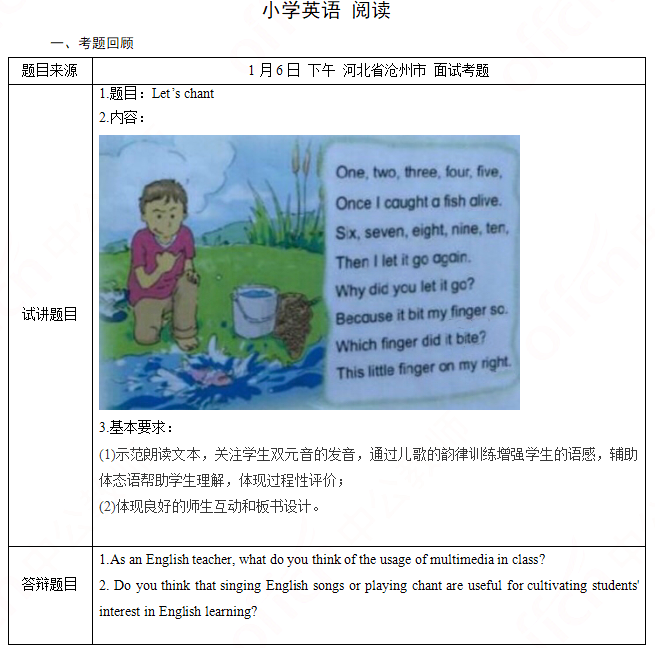
二、考题解析
【教案】
Teaching aims:
Knowledge aim:
Students will master the sound /ai/ in the words “five”, “alive” and so on.
Ability aim:
Students will apply the sound correctly in real communication.
Emotional aim:
Students will be more interest in speaking English.
Key and difficult point:
Key Point: Students will master the sound /ai/ in the words “five”, “alive” and so on.
Difficult Point: Students will apply the sound correctly in real communication.
Teaching procedure:
Step 1: Warming-up
1. Greetings.
2.Play a chant they have learned “tomato, tomato, wash, wash, wash” and lead them to learn another chant this class..
Step 2: Presentation
1. Students watch the picture and tell the teacher what they can see in the picture, and the teacher guide them to present the first part of the chant. Then students watch the picture carefully and predict what’s wrong with the boy, then the teacher guide them to present the last part of the chant.
2. Students observe the sentences and find out what common letters they can find.
3. The teacher teaches them correct pronunciation of the letter “i” in “five”, “right” and so on.
Step 3: Practice
1. Read the pronunciation /ai/ and the words that includes “i” repeatedly.
2. Listen to the tape and follow the tape, paying attention to the intonation of the chant.
3. Students work in pairs to make a chant in 5 minutes.
Step4: Production
1. The teacher writes more words that includes the sound /ai/and students try to read them.
2. Students work in groups to make a story using the picture and the words with the sound /ai/ on the blackboard.
Step5: Summary and Homework
Summary: ask a student to conclude the content of the lesson and summarize with the whole class.
Homework: ask students to search other pronunciation of the letter “i” and list those words accordingly.
Blackboard design:

1. As an English teacher, what do you think of the usage of multimedia in class?
2. Do you think that singing English songs or playing chant are useful for cultivating students' interest in English learning?答案:解析:1.
Multimedia help students to understand our class more smoothly and vividly and enhance their thinking ability. With images, audios and videos, knowledge that is difficult to understand in English is well presented. The students can more truly feel the content of the text, which is helpful to solve difficulties. In the environment of multimedia students can also develop abstract thinking and divergent thinking.
2.
As far as the activity such as singing or chant itself is concerned, it is very interesting and can attract students' attention. The time for students to keep concentrating is limited. If you add such activities as some songs and chants that students like, you can not only attract students' attention, but also cultivate their interest in learning. Therefore, combining knowledge and activities in the classroom allows students to learn while playing and even achieve better effects. -
第12题:
单选题What’s the overall goal of English teaching in basic education stage? _____AIncrease students’ vocabulary and grammar of the knowledge.
BImprove the students’ English learning and foreign cultural interesting.
CCultivate the students’ ability of listening and spoken English.
DCultivate students’ comprehensive capability of language.
正确答案: C解析:
基础教育阶段英语教学的总体目标是培养学生的综合语言运用能力。 -
第13题:
In an English class,the teacher,firstly,plays the radio and asks students to listen to the tape and understand the dialogue.Then,the teacher asks students to read after the tape to imitate the pronunciation.Next,the teacher asks students to repeat the dialogue in pairs...What teaching method does the teacher use in this class?A.Communicative Approach.
B.Task-Based Teaching Approach.
C.The Audio-Lingual Approach.
D.The Audio-Visual Approach.答案:C解析:本题考查听说法
C选项,题干大意:老师采取的是“听音理解对话的含义——模仿——重复”这样一个教学过程,因此,该教师使用的是听说法。综上,C选项正确。
A选项,交际法,故排除。
B选项,任务型教学法 ,故排除。
D选项,视听法 ,故排除。
故正确答案为C项。 -
第14题:

二、考题解析
【教案】
Teaching aims:
Knowledge aim:
Students will know the structure of letter and know how to invite and refuse others.
Ability aim:
Students will improve their reading abilities such as skimming and scanning.
Emotional aim:
Students will use what we have learned into their daily life.
Key and difficult point:
Key Point: Students will know how to invite and refuse others.
Difficult Point: Students will be more confident in speaking English and improve their reading skills.
Teaching procedure:
Step 1: Warming-up
1. Greetings.
2.Play a video of Dear John Letter to lead in the lesson.
Step 2: Pre-reading
Ask students to predict what we will learn today according to the video.
Step 3: While-reading
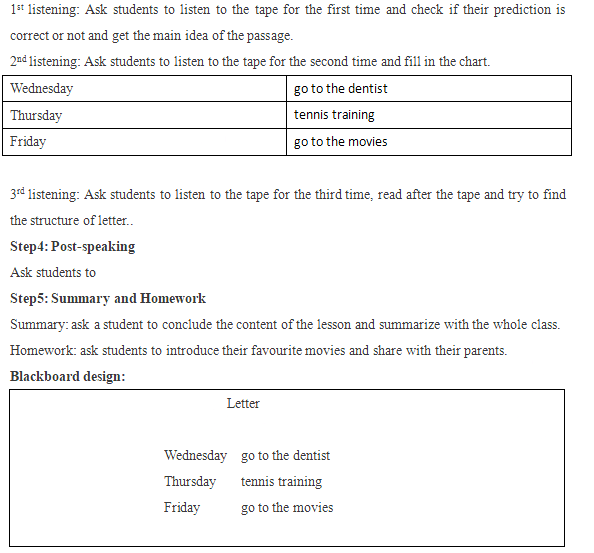
1.How to improve students’ reading ability?
2.Which school did you graduate?答案:解析:1.
The topic should be interesting, which can arouse the interest of students In the class, teachers should give students’ subjectivity to the full play and give them more chance to communicate with each other. And organize various activities to encourage them to express themselves.
2.
I graduated from ...and English is my major. After four years’ study, I have ,mastered the basic professional knowledge in English and I was also award with second prize scholarship. I actively participated various community activities which broaden my horizon. I also engage in teaching practice, which enrich my teaching experience. -
第15题:
初中英语?语法
一、考题回顾
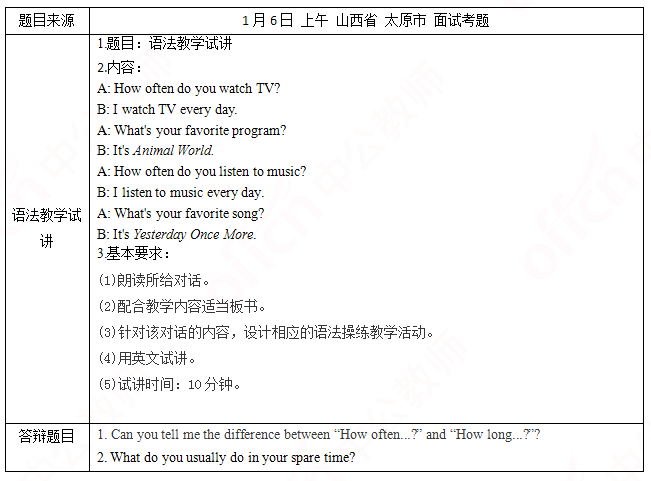
二、考题解析
【教案】
Teaching aims:
Knowledge aim:
Students will know the usage of the frequency adverbs and the sentence structure “How often...?”.
Ability aim:
Students can use the sentence structure freely in their daily life.
Emotional aim:
Students will be more confident in learning English and not afraid of speaking English.
Key and difficult point:
Key Point: Students will know how to use the sentence structure in their daily life.
Difficult Point: Students can cultivate their confidence in learning English.
Teaching procedure:
Step 1: Warming-up
1. Greetings.
2. Ask students what they usually do in their spare time and why, and ask some of them to share with the whole class.
Step 2: Presentation
1. Listen to the tape for the first time and find out what the speaker does every day, and then invite students share their answers.
2. Ask students the following questions: how often does the speaker watch TV? How often does the speaker listen to music? And then write down the sentence on the blackboard.
3. Explain the sentence structure to students: the sentence structure is used to ask questions about how many times something has been done or how many times a state exists in a given period of time.
4. The teacher read the dialogue and ask students to read after it to get a deep understanding.
Step 3: Practice
1. Role-play. Ask students work in pairs and role play the dialogue. Then invite two groups to show in front of the class.
2. Play a game: word cards. Invite two couples of students. Ask one student to choose the card in the box and then ask the other students the question “ how often do you...?” using the activities showed in the card, and then change their role.
Step4: Production
Let students work in groups of 4 and discuss on the topic: how often do you...? according to their own hobbies. After that invite two groups to present in the whole class.
Step5: Summary and Homework
Summary: ask a student to conclude the content of the lesson and summarize with the whole class.
Homework: ask students to ask their friends “ how often do you...?” after class and write down on the exercise book.
Blackboard design:

1. Can you tell me the difference between “How often...?” and “How long...?”?
2. What do you usually do in your spare time?答案:解析:1.
The first sentence structure is used to ask questions about how many times something has been done or how many times a state exists in a given period of time. The second sentence structure includes two different usage: one is used to ask how long does it take. It's mainly used to ask questions for a period of time; the other is used to ask for the length of something.
2.
I really have a great passion for sports, i like to do yoga, cycling and jogging. Take jogging for example. It stimulates me to learn more about body -building. Secondly, I am able to meet new friends through my hobby. Lastly, the hobby will teach me some self-discipline, because to do it regularly is so challenging. -
第16题:
小学英语?语法
一、考题回顾

二、考题解析
【教案】
Teaching aims:
Knowledge aim:
Students will grasp the usage of simple past tense.
Ability aim:
Students will improve their speaking ability in describing things happened in the past.
Emotional aim:
Students will be more confident in speaking English.
Students will arouse their interest in learning oral English.
Key and difficult point:
Key Point:
Students will grasp the usage of simple past tense.
Students will improve their speaking ability in describing things happened in the past.
Difficult Point:
Students will be more confident in speaking English.
Students will arouse their interest in learning oral English.
Teaching procedure:
Step 1: Warming-up
1. Greetings. Talk about the weather.
2. Sing a song called Yesterday Once More, and introduce today’s topic.
Step 2: Presentation
1. Read the dialogue by the teacher, and ask what the dialogue is about.
2. Let the students open the book and read it for the second time, then ask the students to circle the verb in it and ask the similarities among them. They may say that they are different from the verbs they learned. “-ed” is added in some verbs at the end.
3. Tell them that simple past tense is a tense that is used to describe things happened in the past. When we apply it, you should change the verb into past tense. Then introduce the regular and irregular verbs.
Step 3: Practice
1. Fill in the blanks.
a. I _____(clean) the table after we had lunch last evening.
b. My father_____(go) to the company yesterday.
Step 4: Production
1. Make a dialogue with their deskmates about what the students did last weekend. Then invite some students to share their dialogue with their parents.
2. Ask the students to make up a simple story or a joke. Then invite some students to share it with us.
Step5: Summary and Homework
Summary: make a brief summary of what we have learned today.
Homework: Tell the story or the joke to their parents.
Blackboard design:

1. Please talk about your understanding of simple past tense.
2. How do you stimulate students’ interest in learning grammar?答案:解析:1.
Simple past tense is a tense used to describe things happened in the past. When we use it, we need to change the verb into past tense. The verbs are changed in regular form or regular form. Regular verb only needs to add -ed at the end of a word, while irregular verbs have various forms. I will now show an example: My friend looked at me when I touched him. So that’s my understanding of simple past tense.
2.
Grammar can be a little boring for students. But it is essential to learn English. So different activities can be arranged to attract their attention. For example, in the warming-up, I sang a song called Yesterday Once More so that they will know this grammar point is around us and frequently used. Then, in the presentation part, I will let the students take the initiative to find the rules of simple past tense. At last, I asked students to talk about their daily lives and share stories or jokes with simple past tense, so they will use the tense and do not get bored with much mechanical drilling. So I believe they will be interested in my grammar lesson. -
第17题:
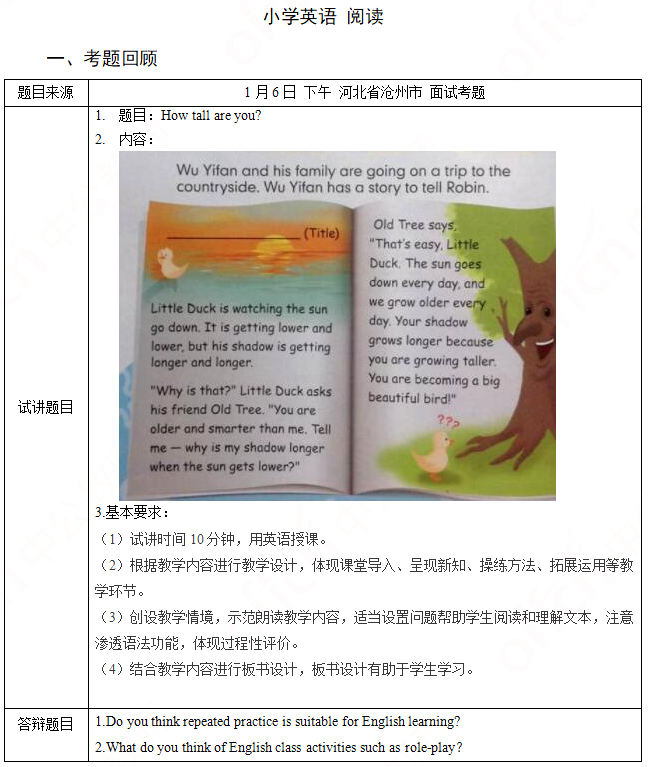
二、考题解析
【教学设计】
Teaching aims:
Knowledge aims:
Students will know about the relation between shadow and the sun through reading the passage.
Students will master the usage of comparative degree in the reading.
Ability aim:
Students will apply the comparative degree to retell the story.
Emotional aim:
Students will be more interest in learning English.
Key and difficult point:
Key Point: Students will master the usage of comparative degree in the reading.
Difficult Point: Students will apply the comparative degree to retell the story.
Teaching procedure:
Step 1: Warming-up
1. Greetings.
2. Play a riddle--it rises up and goes down every day, what is it? and students guess it’s the sun, then lead to the story about the sun.
Step 2: Pre-reading
According to the word “sun”, students have a brainstorm about what natural phenomenon about sun they have known.
Step 3: While-reading
1. Fast reading: students read the passage fast and figure out what the tree and the duck are talking about.
2. Careful reading: students read the passage carefully and answer the question: why does the shadow get longer when the sun gets lower? And underline the words with “er”.
3. The teacher explains the words with “er” to the students.
Step4: Post-reading
1. Students work in pairs to make a role-play (one is the little duck, the other is the old tree) to make a conversation according to the passage.
2. Students work in groups to find the real reason why the shadow gets longer when the sun gets lower.
Step5: Summary and Homework
Summary: ask a student to conclude the content of the lesson and summarize with the whole class.
Homework: students tell the story to their parents.
Blackboard design:

1.Do you think repeated practice is suitable for English learning?
2.What do you think of English class activities such as role-play?答案:解析:1.
Reciting is a way of practicing. There is a gap between understanding English and using English. For students, even if they think they can remember what they learn in class, after class while applying the knowledge taught in class, it possibly doesn’t work very well. So it is a practice way but we can not only use it. We need to use more practice ways together reciting to ensure the effect of teaching and learning.
2.
English class activities play an important role in English teaching. These performances can stimulate students' interest in learning English, mobilize students' enthusiasm for learning English, activate classroom atmosphere, reduce students' learning pressure, help students overcome fear of English learning, cultivate students' participation awareness, cooperation spirit and leadership ability. -
第18题:
初中英语?阅读
一、考题回顾

二、考题解析
【教案】
Teaching aims:
Knowledge aim:
Students will grasp and understand the main and detailed information of the passage.
Ability aim:
Students will improve their reading and speaking skills.
Emotional aim:
Students will foster the interest and desire of learning English and take part in speaking activities actively.
Key and difficult point:
Key Point: Students will totally understand the content of the passage.
Difficult Point: Students will foster the interest of learning English, and take part in speaking activities.
Teaching procedure:
Step 1: Warming-up
1. Greetings.
2. Show students pictures about different types of transportation and naturally lead to today’s topic.
Step 2: Pre-reading
1. Ask students two questions and some volunteers will be invited to share their answers.
Q1: How do you come to school?
Q2: How do your parents go to work?
2. Ask students to predict the main idea of the passage based on the above discussion and pictures on the screen.
Step 3: While-reading
1st reading: Ask students to read the passage for the first time and check their prediction. Besides, they need to find out which countries are mentioned in the passage and circle them.
2nd reading: Ask students to read the passage for the second time and complete the following chart. Some students will be invited to finish it on the blackboard.

Step4: Post-reading
Discussion: ask students to discuss the advantages and disadvantages of different modes of transportation. Four students in a group, after five minutes, some groups are supposed to show their results.
Step5: Summary and Homework
Summary: ask a student to conclude the content of the lesson and summarize with the whole class.
Homework: ask students to investigate their friends’ way of going to school and find some interesting ways of transportation on the Internet.
Blackboard design:
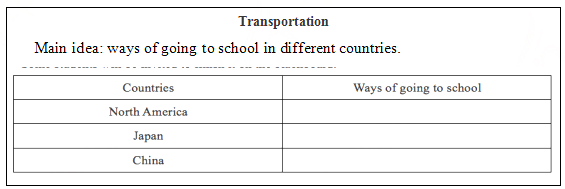
1. How to improve students’ reading and speaking ability in your class?
2. How did you evaluate the performance of students in the class?答案:解析:1.
It is very important to improve students’ reading and speaking abilities. In my class, I take three specific steps to improve their reading and speaking abilities. Firstly, before reading the article, I ask the students to guess the main idea of the article according to my questions and pictures on the screen. As you heard, this can not only exercise students’ guessing ability, but also help them read the passage with questions. In the while-reading part, I set two times of reading, namely extensive reading and intensive reading. Obviously, students’ scanning ability and the ability to grasp detailed information can be improved. It also helps them form good reading habits. As for speaking ability, I organize a discussion activity without standard answers. Students can express their views freely in groups. In this way, their reading and speaking abilities can be improved a lot.
2.
Students are under a stage of growing and developing. They are eager to be evaluated and encouraged by their teachers. At the same time, students are different, and their acceptance and abilities of learning are different. Therefore, in my class, I have adopted a variety of different evaluations. For the students who answered correctly, I would praise them directly, such as “excellent”, “you can find the answer so fast”. For those students who dare not answer questions or did not find out the answers, I just encouraged them and guided them to say the answers, and gave some encouraging comments, like “nice try!”, “you’ve made a great progress”. Also, some students made mistakes. In my class, instead of directly blaming the student for being wrong, I asked other students to help him/her and give them a proper evaluation. -
第19题:
初中英语?口语
一、考题回顾
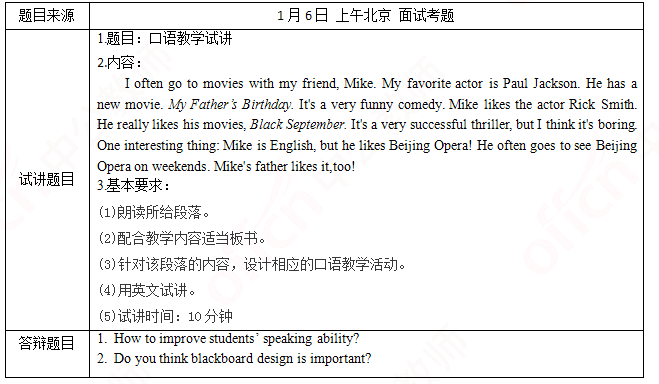
二、考题解析
【教案】
Teaching aims:
Knowledge aim:
Students will know how to express their hobbies and interest.
Ability aim:
Students will improve their abilities of speaking and listening.
Emotional aim:
Students will be more confident in speaking English.
Key and difficult point:
Key Point: Students will know how to express their hobbies and interest in English.
Difficult Point: Students will be more confident in speaking English and not be afraid of speaking English in public.
Teaching procedure:
Step 1: Warming-up
1. Greetings.
2.Sing a song of Mick Jackson to lead in the lesson.
Step 2: Pre-speaking
Ask students to look at the picture of Paul Jackson and Beijing Opera to predict what we will learn today.
Step 3: While-speaking
1st listening: Ask students to listen to the tape for the first time and check if their prediction is correct or not and get the main idea of the passage.
2nd listening: Ask students to listen to the tape for the second time and tick and cross.
Mike’s favorite actor is Paul Jackson. ( )
Mike’s father often goes to see Beijing Opera on weekends.( )
Black September is a very successful thriller.( )
3rd listening: Ask students to listen to the tape for the third time, read after the tape and invite several students to summarize how to express hobbies.
Step4: Post-speaking
Ask students to have a discussion about their hobbies, four students in a group and give them 5 minutes.
Step5: Summary and Homework
Summary: ask a student to conclude the content of the lesson and summarize with the whole class.
Homework: ask students to introduce their favourite movies and share with their parents.
Blackboard design:

1.How to improve students’ speaking ability?
2.Do you think blackboard design is important?答案:解析:1.
The topic should be interesting, which can arouse the interest of students In the class, teachers should give students’ subjectivity to the full play and give them more chance to communicate with each other. And organize various activities to encourage them to express themselves.
2.
There is no doubt that blackboard design plays a very important role in teaching process. First, it should has title. Secondly, The key and difficult points should be prominent, which enables students to master the knowledge. What’s more, the blackboard design should be logic and clear. -
第20题:
初中英语?词汇
一、考题回顾

二、考题解析
【教案】
Teaching aims:
Knowledge aim:
Students will master the expression of asking jobs-What does she do? She is a doctor.
Student will understand words about different jobs: doctor actor policeman and so on.
Ability aim:
Students will improve their abilities of speaking and listening.
Emotional aim:
Students will be more confident in speaking English. And show their respect to different jobs.
Key and difficult point:
Key Point: Students will master how to ask jobs in English.
Difficult Point: Students will use the sentence structure in daily life.
Teaching procedure:
Step 1: Warming-up
1. Greetings.
2. Sing a song and ask student what the song mainly about. “be what you wanna to be”
Doctor actor lawyer or a singer
Why not president be a dreamer
You can be just the one you wanna be
Police man fire fighter or a post man
Why not something like your old man
You can be just the one you wanna be
Doctor actor lawyer or a singer
Why not president be a dreamer
You can be just the one you wanna be
Step 2: Presentation
1. Show pictures of different jobs and explain the working environment, working place, working content. the spelling and pronunciation of the words.
2. Introduce the new sentence and write is on the blackboard
“What do you do?”
“I’m a student”
“What does she do?”
“She is a doctor.”
Step 3: Practice
1. Ask and answer between teacher and student.
“What do you do?”
“I’m a student”
2. Show a video clip from “ZOOTOPIA” and ask students what does Judy Hopps do? What does Gazelle do?
3. Listen to the tape and finish the exercise on the text book.
Step4: Production
1. Role-play: ask students to make a dialogue according to the picture in the textbook.
2. Survey: ask students to make a survey about their parents’ jobs.
Step5: Summary and Homework
Summary: ask a student to conclude the content of the lesson and summarize with the whole class.
Homework: ask students to practice the sentence structure learned today with desk mates after class.
Blackboard design:

1.What are the teaching aims of your class?
2.Talk about your blackboard design.答案:解析:1.
There are there aspects of the teaching aims; they are knowledge aim, ability aim, and emotional aim. Knowledge aim: Students will master the expression of asking jobs-What does she do? She is a doctor. And Student will understand words about different jobs: doctor actor policeman and so on. Ability aim: Students will improve their abilities of speaking and listening. Emotional aim: Students will be more confident in speaking English. And show their respect to different jobs.
2.
There are three parts of the blackboard design. The title, new words and new sentence pattern. It’s clean and logic, easy for students to take some notes. -
第21题:
小学英语?阅读
一、考题回顾
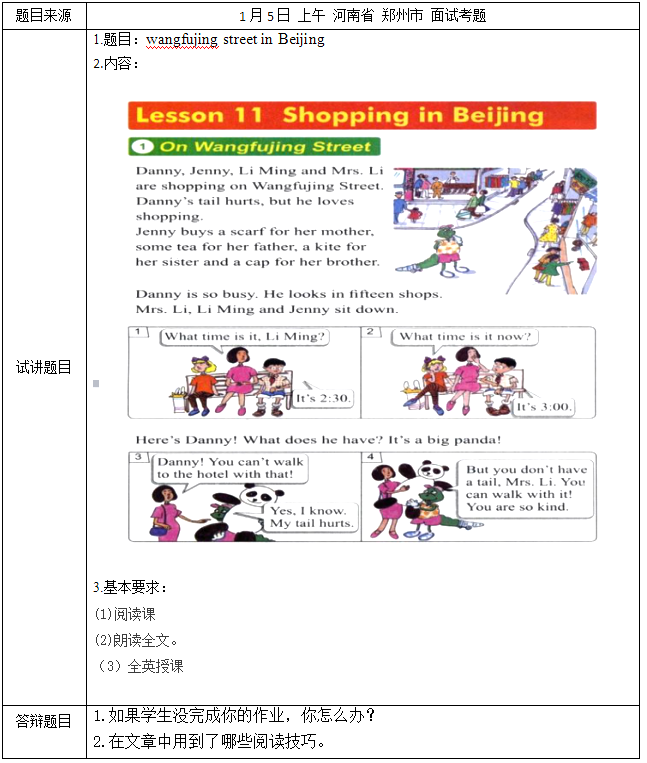
二、考题解析
【教案】
Teaching aims:
Knowledge aim:
Students can master the sentence :”what time is it? it is ..” and you can/ can not ...”
Ability aim:
Students can improve their reading skills including scanning and skimming skills
Emotional aim:
Students can be more interested in English and take part in activities.
Key and difficult point:
Key Point: know how to ask about the time and master the sentences::”what time is it? it is ..” and you can/ can not ...”
Difficult Point: use the sentence structure in daily life.
Teaching procedure:
Step 1: Warming-up
1. Greetings.
2. Ask students how did they spend their weekend.
3. Ask students “do you know wangfujing street in Beijing”
Step 2: Pre-reading
1. show a picture about wangfujing street and ask “what can you see in this picture”
2. draw a clock and ask students “Do you know how to ask about time?” and “what can you do at this time?
Step 3: While-reading
Global reading: Ask students :”how many characters in the dialogue?” and “where are they”
Detailed reading: what does Jenny buy and who will get the gift?
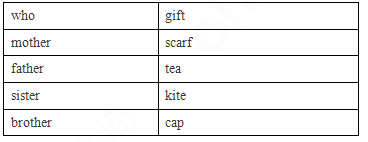
Step4: Post-reading
1. Role-play: two students in a group. One student act as traveller and one student is tour guide. Give them 5 minutes to make dialogue with what we have learnt today.
Step5: Summary and Homework
Summary: ask a student to conclude the content of the lesson and summarize with the whole class.
Homework: ask students to practice the sentence structure learned today with desk mates after class.
Blackboard design:
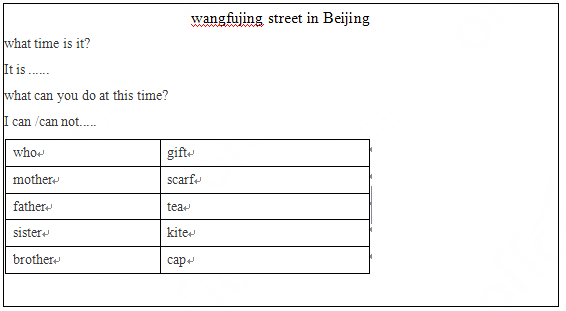
1. What will you do if the students don't finish your homework?
2. What reading skills are used in the passage?答案:解析:1.
Homework is an important means to show students' intelligence and improve their quality. Doing homework is the summary and consolidation of the knowledge learned, so doing homework is one of the important means for students to master knowledge.Third, fourth grade students such as not to assign homework is not conducive to the timely review of students to consolidate the knowledge, is not conducive to students to develop good learning habits. Therefore, how to help students homework on time with high quality is the primary task of every teacher.
firstly, I will talk to students to analyze the reason why he did not finish the homework. The reason maybe as follows: He dose not how to do it without any help. or he thinks homework is so much and can not finish it and so on. Then I will take action according to the reasons.
2.
In order to make students be more interested in reading and can understand the knowledge clearly, I use detailed reading to make students find the detail information and global reading to find the how many characters in the dialogue. In the reading passage. students can master and scanning skills and skimming skills. They can understand the passage step by step. -
第22题:
初中英语?阅读
一、考题回顾
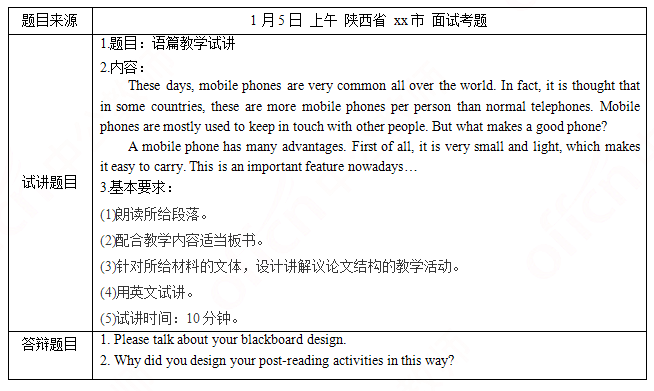
二、考题解析
【教案】
Teaching aims:
Knowledge aim:
Students will master the basic format of argumentation and get the general idea of the passage.
Ability aim:
Students will write argumentation to express their views on different issues.
Emotional aim:
Students will be interested in learning English and are no longer afraid of writing in English.
Key and difficult point:
Key Point: Students will master how to write an argumentation.
Difficult Point: Students will express their opinions in daily life through argumentative essays.
Teaching procedure:
Step 1: Warming-up
1. Greetings.
2. Show students different types of mobile phones and ask them to discuss similarities and differences.
Step 2: Pre-reading
Ask students two questions and some volunteers will be invited to share their answers.
Q1: Do you have a mobile phone? Are you satisfied with it?
Q2: What is the most important factor when you choose your mobile phone?
Step 3: While-reading
1st reading: Ask students to read the passage for the first time and figure out the main idea and genre of the passage.
2nd reading: Ask students to read the passage for the second time and pay attention to the structure of the passage. Some students will be invited to try to summarize the format of the argumentation.
Step4: Post-reading
1. Discussion: Four students in a group, ask them to discuss the advantages and disadvantages of mobile phones for junior high school students.
2. Outlining: Ask students to write an outline based on their opinions about the influence of mobile phones for junior high school students.
Step5: Summary and Homework
Summary: ask a student to conclude the content of the lesson and summarize with the whole class.
Homework: ask students to revise their outline and complete their composition after class.
Blackboard design:
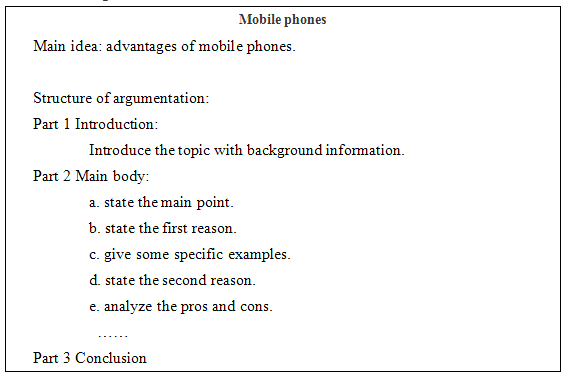
1. Please talk about your blackboard.
2. Why did you design your post-reading activities in this way?答案:解析:1.
Thanks for your question. As we all know, blackboard design is very important for teaching. Firstly, it can help teacher present the teaching content. Students can understand the main content of the lesson easily. Secondly, it helps students to break through teaching key and difficult points. Students can have enough time to think and observe the knowledge. Thirdly, it helps student to take notes and develop good writing habits. Based on these functions, my blackboard design can be divided into three parts. The title is very simple and clear. And then is the main topic of the passage, students can easily understand the task of today’s lesson. The last part is the key point of the lesson. I present the basic format of argumentation, which takes more time in class. By doing so, students can easily master the argumentation format and write their own outline according to it.
2.
Thanks for your question. The purpose of language learning is to communicate. In my opinion, there are only two ways to communicate, that is, speaking and writing. In this class, I designed it as a reading lesson. After reading the article, students had a good understanding of the topic and the basic format of the article. So I designed a discussion first. Students could express their views freely on the topic. Of course, the format of argumentation was taught in class, so students were supposed to practice it. So I organized the second activity, that is, wrote an outline. Students could write their own outlines according to what they have discussed before. In this way, the input and output of this lesson will be more reasonable and diverse. -
第23题:
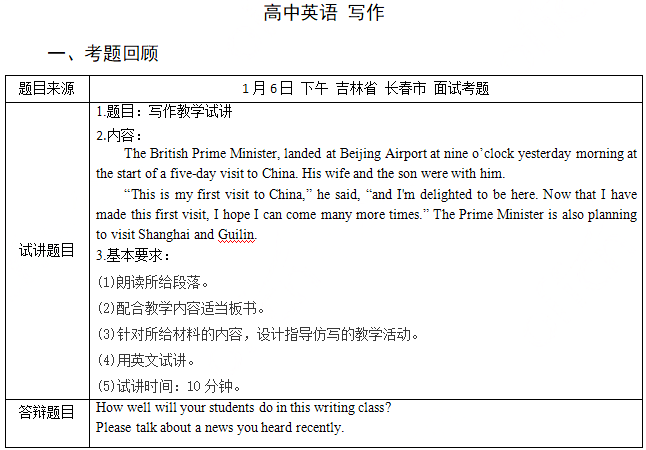
1.How to improve students’ interest in learning English?
2.Please introduce the person you admire most.答案:解析:1.In this class, I mainly use multimedia to arose students’ interest. The city Pompeii is a place full of mystery and tragedy, through directly show the pictures and play the video of it, I can help my students feel that they are personally on the scene. Therefore, they will be much eager to learn something about this lost city and read this passage more carefully. Besides, I design a role-play for them to let all the class involve in the learning.
2.The person I admire most is the English teacher who once taught me English literature in university. She is an elegant and knowledgeable professor, and always be patient when answering our questions. We have learnt a lot, both academic knowledge and life experience, from her. She is also a good pianist outside the classroom, and I have listened her play the piano in the New Year party of our faculty. I hope to become a teacher like her in the future and bring positive influence to my students. -
第24题:
单选题For better classrooru management, what should the teacher do while the students are doing activities?AParticipating in a group.
BPreparing for the next procedure.
CMoving around to monitor, prompt students and provide help.
DStanding in front of the class.
正确答案: C解析:
